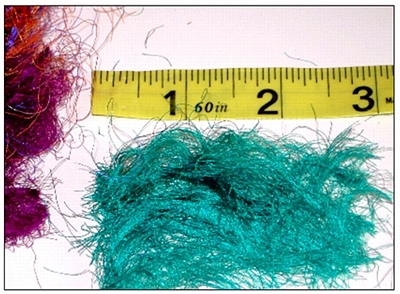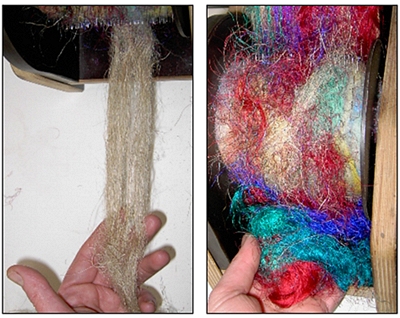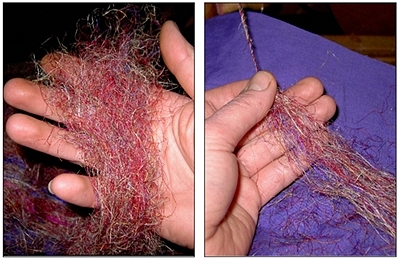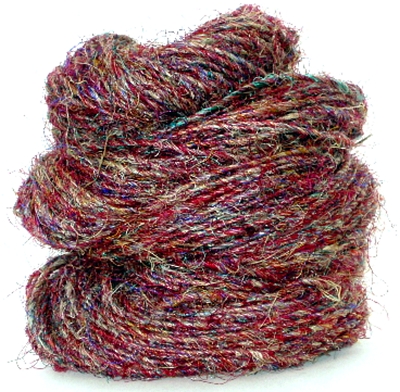Hemp, hemp, hurrah!
Sometimes controversial, always
strong, and in this case a catalyst for creativity.
Hemp has been around since
before recorded history. It has been speculated
that our first printed books were made with hemp
paper. I's uses range from medicinal to recreational,
and everything in between. (We've all heard that
George Washington was a hemp farmer, right?)
 With
new processing techniques, much to the chagrin
of purist linen lovers high and low, hemp yarn
has been making a lasting impression on the fiber
world. Revered for its durability, admired for
its sustainability, used for its versatility
and loved for its accessibility. It is an all-round
fiber lover's dream. With
new processing techniques, much to the chagrin
of purist linen lovers high and low, hemp yarn
has been making a lasting impression on the fiber
world. Revered for its durability, admired for
its sustainability, used for its versatility
and loved for its accessibility. It is an all-round
fiber lover's dream.
  My personal favorite way to spin hemp is when
it has been blended on a drum carder (no distaff
needed.) With fibers that will add color, compliment
its strength and hold up to the rigors of setting
the twist on a plant fiber. I've found the easiest
way to do this is by simply taking hemp
top (available from Louet sales, USA) & blending
it with equal parts recycled silk sari bits (available
from the
wool peddler.) My personal favorite way to spin hemp is when
it has been blended on a drum carder (no distaff
needed.) With fibers that will add color, compliment
its strength and hold up to the rigors of setting
the twist on a plant fiber. I've found the easiest
way to do this is by simply taking hemp
top (available from Louet sales, USA) & blending
it with equal parts recycled silk sari bits (available
from the
wool peddler.)
Before beginning to blend everything up, it is
imperative to cut up the sari into bite-sized
bits, removing all knots, selvages and other
surprises that may be lurking in the pile of
eye candy. (An activity best saved for Thursday
night TV watching.)
This is vital for two reasons. First, longer
bits will essentially get tangled around the
drum of your drumcarder. Not fun. Two, bits longer
than 3 or 4 inches are unreasonably hard to draft.
(Again, not fun.)
  With that necessary evil in the past, it is time
for drum carding fun. With that necessary evil in the past, it is time
for drum carding fun.
Mix it up
I
like to run the fibers on
the carder in alternating layers. I
take
equal weights of the hemp
top and sari bits, starting
with
hemp, then I add sari,
back and forth, until
the drum is full.
To ensure a thorough blending, I like to run
the batts thru the carder again and again. Four,
sometimes five times. Of course, your tastes
may vary, and the yarn you envision creating
may not call for such an even distribution of
the fibers.
(Remember to remove the batts
with care, as those little bits like to fly away.)

Spin it like you stole it
There isn't anything very hard, or even tricky
about spinning this type of concoction. In fact,
it lends itself eloquently to being a good
transitional blend, for when you are ready to
spread your spinning wings and try things other
than wool (or if you are one of those unfortunate
souls allergic to wool. Being carded,
it drafts smoothly. It can take a lot of twist,
and no matter what you do, it is going to be
pretty. A great confidence booster.
Wheel/Spindle prep.
If you have multiple flyers and ratios for your
wheel, here is where you would want to switch
to a lace flyer and set your wheel at a higher
ratio. If you don't have a lace flyer, a regular
one will work just the same. (Essentially, lace
flyers and higher ratios eliminate a lot
of treadle work. It is entirely possible to spin
a high-twist yarn on low ratios with bulky flyers.
It only takes a bit more effort on behalf of
the spinstress.)
The same 'rule' applies for spindle spinning
this hempy mixture. A balanced light-weight spindle
will best produce a fine, high-twist, strong
yarn.
A good rule of
thumb, especially helpful if you are spinning
on a spindle, or on a wheel that only has one
ratio: the thinner your yarn, the more twist
you will need. I've found that I like these
fibers best spun at a sport weight or thinner.
The yarn I made
here was spun firmly, yet not overspun or corkscrewed. An
even handed laceweight knitting yarn, at 24
wraps per inch (WPI), 5 twists per inch (TPI)
with a twist angle of 15. (For more on measuring
twist angles, read the "Get Spun' article,
coming in the summer issue of Knittyspin.)
  Getting to it..... Getting to it.....
For starters, I would highly recommend putting
a pillow case or a piece of fabric on your lap
to catch the sheddings. You will be glad you
did, as the little bits and threads like to roam.
As with any batt of fiber, gently rip off a manageable
strip, and get to it. To insure a good union
with the leader, I spin the first few inches
smaller and tighter than what the yarn is
going to be. After that it is only a matter of
'spinning rhythm' -- matching your draft with
the treadle. (Or, drafting to match the spin
of your spindle.) Gently smooth the fibers
into the twist, but don't force them.
*If this was
straight hemp I most likely would employ wet
spinning. Wet spinning allows you to get all
of the ends of the fiber into the twist, to produce
a smoother & subsequently
softer yarn. With the addition of the sari fibers
to this brew, I've found I'd rather not fight
the fibers into shape. Allowing some ends (and
even some noils) to roam free adds an exciting
dimension to the finished yarn.
 Wet spinning Wet spinning
Wet spinning isn't really "wet". I
think a more accurate name would be "misted" or "slightly
damp".
This technique is very helpful in achieving a
smoother, softer yarn. The moisture on your fingers
will enable you to gently manipulate the ends
of the fibers into the twist.
To do this, slightly dampen
your fingers on the hand that is controlling
the twist, either with a spray bottle/plant mister,
or a few drops of water from a bowl or cup. Once
you get to spinning, you will see how once the
fibers touch the dampness, a bit of spinning
magic occurs. Some spinners use natural oils
such as lanolin as their lubricant. It's all
a matter of personal tastes and finding what
works best for you.
Weave in ends [see
pics at left]
When I come to the end of my fibers,
I finish the bobbin almost the same way I started
it. I spin the remaining inches tighter and
finer than the yarn proceeding it. With an
added twist. I loop the last wee bit around
my finger, give a few more treadles and allow
it to join in the twist above it. Giving the
yarn a nice, somewhat 'clean' end.
This method of finishing
can be used with any type of fiber... I'm
not sure if it is "proper" or
not, as I've never heard anyone talk about
it, it is one of those things that seemed intuitive
to me. So, your mileage may vary.
Setting the twist
Once your yarn is wound off the bobbin, you will
need to set the twist. Setting the twist on a
plant fiber uses a different method than with
wool.
You will need to give it a quick (a minute or
three) bath in some boiling water. (Some plant
fibers, especially certain cottons will take
longer.) In this case, add a few glugs of vinegar,
on occasion the recycled silk sari likes to bleed
dye, aqnd the vinegar helps to ‘set’ it.
Use some tongs or a large wooden spoon to remove
your yarn from the boiling water. Once it has
cooled enough to touch, give it a few good whacks & hang
to dry. It is perfectly okay to block or weight
down plant fibers when they are drying, it won't
have any ill effects on your knitting yarn. Have
no fear if it feels a bit rough. Both fibers soften
considerably with wear and washing.

Next time someone asks you what your beautiful Clapotis or Calorimetry is
made from, you can say "It's made from my
hemp yarn!"
If they ask if they can smoke it, say "Sure,
it's really great if you enjoy headaches
and burning hot smoke in your lungs." And
then you can point them to some educational web
resources like this "101
uses for hemp"

Have an spinning issue
or question you would like to see resolved
here? Send email to Symeon. |

